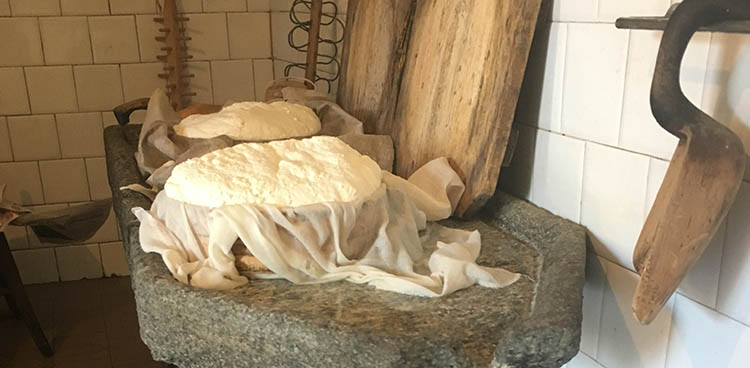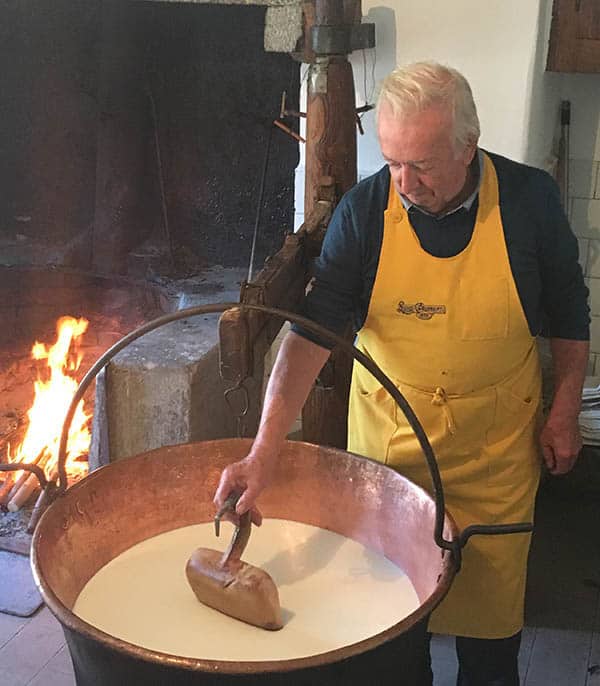
In this multi-part travelogue series, Anna Juhl, founder of Cheese Journeys, takes you deep into the world of cheese. From the birth of a cheese in the Alps to an after-hours cheese party at Philadelphia’s DiBruno Bros., each installment is a behind-the-scenes adventure. Come back every other Wednesday for a new story.
The Birth of a Cheese: Witnessing Traditional Alpine Cheesemaking
Whether you’re a professional who’s witnessed it countless times in different settings or a true novice, the chance to see cheese made by hand over an open fire in a big copper kettle full of piping hot whey and unseen floating curds—the way it’s been done for thousands of years—is truly a special and unforgettable experience. If you’ve never fully understood it, that magical moment of formation (formaggio) is the only explanation you’ll ever need.
To launch my first Northern Italy tour, I hired journalist Dave Gibbons, co-author of three cheese books and currently the cheese columnist for Wine Spectator magazine. Dave knows Italy well, but not so well that there isn’t room for some unexpected adventures.Our trek to the old-time cheesemaking demonstration started at the end of Cheese Journeys’ fourth tour to France in the fall of 2016. Trusting GPS directions, we headed southeast from Geneva for the Simplon Pass into Italy.
To be honest, I was exhausted from weeks of travel in Europe, hosting two consecutive tours. With limited knowledge of Italian cheese makers and only speaking a few words of the language, I had serious doubts about this scouting trip. Thinking it was too late to turn back now, I closed my eyes and dozed off. When I awoke, there was a breathtaking view of the Italian Alps looming in front of us in the early evening alpenglow. A little rest and that view was enough to push me past my comfort level. And, as the next day unfolded—wow—was I ever glad I did.
Darkness set in and we followed a circuitous route behind factories and warehouses, finally stopping at what appeared to be some sort of border crossing station. Dave told me not to worry, we were taking a ferry: The GPS map labeled it navetta (“little ship” in Italian) but there was no water in sight.
A uniformed guard-type sold us tickets and after waiting in line, we followed the car in front of us, driving up onto a flatbed railroad car.
Soon, the train lurched, wheels squealing, into a pitch-black tunnel and sped up for a 25-minute shaking, rattling ride into what seemed like the past.
In the dark, a hundred thoughts flashed through my head: This is crazy. Who travels like this? How is our car secured to this train? Is it safe? Did they hide from the Nazis in here during WWII? The whole scenario was something right out of a John LeCarré novel. Who knew there was a 1940s-era “train ferry” under the mountains between Switzerland and Italy?
The car-train miraculously emerged on the Italian side in Domodossola, the county seat of the Ossola Valley. Laughing but exhausted, we drove another 40 minutes and checked into our charming hotel on the shores of Lago Maggiore. The next morning, feeling rested and energized from more than one cup of espresso, I was ready for our cheesemaking demo appointment. It was arranged by Giovanni Fiori, who along with his brother Davide represents the fifth generation to run their family firm, Luigi Guffanti 1876, Italy’s premier affineur (stagionatore in Italian)—the country’s equivalent to Britain’s Neal’s Yard Dairy.
The Fiori brothers were instrumental in restoring and reviving the ancient Latteria Turnaria in Oira, a village of old stone houses not far from Domodossola. The Ossola Valley juts north into Switzerland and is surrounded by gorgeous alpine cheese terroir.
Fascinated by their family story, I greeted Giovanni Fiori, a cheerful man, who quickly ushered me up a flight of stone steps and into the cheesemaking room where he introduced me to 82-year-old artisan Remo. During the summer, Remo, who’s made cheese since he was a teenager, still works at an alpine creamery further up the valley at a 6,500feet elevation, a two-hour trip by car and then on foot.Remarkable!
Watching Remo’s effort and focus left me awestruck. He filled the copper kettle with about 100 liters of milk, then warmed it over the hardwood fire as he stoked it. He then added the rennet to curdle the milk bringing it to a custard-like consistency. When his stubby wooden shovel could stand upright in the curds, they were ready to be cut— which Remo did first with the shovel and then with another special tool that looked like half a broom handle with a section of thick metal wire woven around it.
Then came the birth of the cheese: like a priest in some mysterious alchemistic ritual, Remo submerged his arms in the 100-degree whey and patiently gathered and formed the curds. I caught a tantalizing glimpse of the soon-to-be cheese and, after about five minutes, he lifted up one large blob weighing about 10 kilos (22 pounds). He divided it in half, and put the two pieces into wooden hoops lined with cheesecloth, pressed them down and tightened the hoops to continue their draining. Next, he pressed them under 40-pound stone weights.
Remo stoked the fire again and swiveled the kettle of whey back on it to start making ricotta. The fire emitted tantalizing wisps of smoke and Remo scooped out a small handful of squeaky ricotta curds, offering us a taste. “Ricotta” means recooked; I never really knew why. Now I do! Giovanni piped up, with his charmingly accented English, and explained: “This is formaggio in the most ancient sense of the word—the birth and formation of a cheese. And you see, the smoke there, that gives the ricotta a nice slightly smoky flavor, which is also very traditional.”
Later, we visited Guffanti’s headquarters in Arona, 45 miles south of Oira, and tried some aged alpine ricottas that looked like bluish green cannonballs and offered delicious salty, savory, smoky flavors like no other ricotta I’ve ever encountered.
For cheese aficionados, Remo’s demo was a quasi-religious experience. After witnessing the process, I couldn’t stop smiling as I pulled out my journal and quickly put the Oira creamery on my itinerary for future Cheese Journeys to this area.
Anna Juhl’s company, Cheese Journeys, takes turophiles around the world on unique experiences within the cheese world. Learn how she started this incredible business and where she’s headed next. Follow cheesejourneys on Instagram to see all the action from Anna Juhl’s journeys.







great addition to the site!